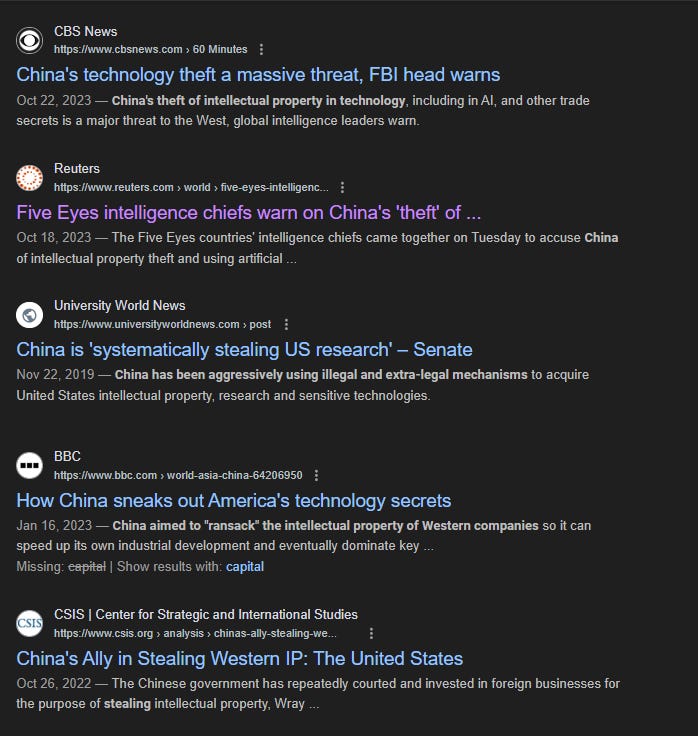Stealing Success: How IP Theft Built Nations
How Industrial Espionage, IP Laws, and Development Strategies Shape Economic Power"
The United Nations Conference on Trade and Development (UNCTAD) uses its Frontier Technology Index to assess countries’ readiness to adopt emerging technologies. It evaluates key factors like adoption of software/AI in producing goods & services, workforce skills, R&D investment, the performance of industries tied to frontier technologies (e.g., IoT, AI, climate tech), and access to finance for technological innovation.
Below is the Business Innovation-Income curve. Using a dataset of countries’ average income per person at purchasing power parity and their Frontier Technology Index scores, I plotted an exponential line of best fit to analyze the relationship between innovation and income.
Countries like the UAE and Saudi Arabia are above the best-fit line, indicating that their people’s average incomes exceed what their innovation index suggests—unsurprising given their reliance on selling raw hydrocarbons. We’ll call these economies the “income overperformers.” Conversely, countries like China, South Korea, the U.S., and India fall below the line, suggesting their business innovation potential could drive even higher living standards than currently realized. We’ll call these “technological growth opportunity economies”.

While metrics like the Frontier Technology Index highlight nations' readiness for innovation, history shows that countries often relied on industrial espionage to close gaps—an accusation now frequently leveled against China. In the West, China is often portrayed as a "stealing country," with Western media heavily emphasizing stories of Chinese IP theft.
Western Critics often attribute China’s technological rise almost solely to industrial espionage. Industrial espionage refers to the illegal practice of spying and obtaining proprietary information about a business’s operations, technologies, products, or strategies. While industrial spying has played a role, relying only on stolen IP would have left China decades behind — just like the former Soviet Union. Copying technology is inherently reactive; it limits innovation to reproducing what others have already done rather than driving the creation of cutting-edge advancements. When the Soviets reverse-engineered American semiconductor chips, firms like Intel and Texas Instruments were already advancing to the next generation. This cycle of dependency hindered Soviet innovation, and IP theft alone cannot explain China’s rapid progress.
Currently, China is behind in a few sectors (i.e. semiconductors, aerospace, biotech, and pharmaceutical drugs), but in other sectors, China is on par with or arguably excelling past the West:
China's success extends far beyond copying—Chinese businesses and entrepreneurs also excel at scaling, improving foundational designs, and developing patents.

Patents as a Signal
When a country like China engages in both industrial espionage and patent development, it signals a shift from a “copier economy” to an “inventor economy,” a hallmark of transitioning toward advanced economic status. The U.S. underwent a similar shift in the mid-1800s, moving from copying British patents to leading the Second Industrial Revolution (1870–1914). Innovators like Alexander Graham Bell, who made the telephone, Christopher Sholes, who developed the typewriter, and Henry Ford, who revolutionized car production with the assembly line, exemplified the shift. Similarly, we may now be witnessing China's transition as it leads the AI and Green Revolutions.
In this article, we will explore the original industrial "stealers"—how other European countries on the continent stole from Britain to industrialize in the 1800s.
What is Intellectual Property (IP)?
Let’s start by talking about what Intellectual Property is.
Intellectual Property (IP) refers to non-material creations of the mind—such as inventions, designs, symbols, and artistic works—that hold distinct value, though this value may not always be immediately tangible in the marketplace. While concepts of protecting valuable knowledge have existed for centuries, neither ancient Greek nor Roman law recognized intellectual creations as property, though they regulated trade and contracts. The Formalization of IP began to develop in Renaissance Europe (1250–1600 AD).
In 1291, the Republic of Venice enacted laws to safeguard its glassmaking techniques. Artisans were ordered to move their workshops to the island of Murano to limit the spread of their methods. Severe penalties, including the death penalty, were imposed on glassmakers who emigrated or disclosed these secrets. These practices represent early forms of trade secret protection, which predates modern IP law.
To avoid a Eurocentric view, other civilizations independently developed forms or concepts of trade secret protection as well:
In Tang & Song China (618-907 & 960-1279 AD): The state protected knowledge of gunpowder, salt production, and iron technologies to maintain military and economic dominance.
In the Abbasid Caliphate (750 AD-1258 AD): The Arabs from Baghdad (a city in modern day Iraq) captured Chinese people in a war and learned from them to establish paper mills in Baghdad. The Caliphate refined and monopolized the paper industry. The Abbasids’ innovations in papermaking became a trade secret.
In the Benin Kingdom (1440-1897 AD) of modern-day Southwest Nigeria: The Edo people of the Benin Kingdom developed intricate bronze casting techniques for creating plaques and statues. These techniques were restricted to royal guilds under the King’s patronage, ensuring their exclusivity.

But back to Europe, the Venetian Patent Statute of 1474 marked the first formal patent system, granting inventors exclusive rights to their creations in exchange for public disclosure. Unlike earlier systems tied to guilds or rulers, it recognized individual inventors as idea owners.
How did IP emerge in Europe?
In Renaissance Europe, most of the time, artisan guilds regulated access to knowledge and processes, fostering an early sense of IP by valuing skills distinct from the products they created. Guilds guarded their methods as trade secrets and opposed new machines or techniques that threatened their job security. However, their resistance to change often clashed with monarchs, who sought to incentivize innovation for economic and strategic gains.
In 14th-century England, Edward III issued letters of protection to attract foreign artisans, enticing them to settle in England and train local apprentices in the wool and textile trade. By Elizabeth I’s reign (1558-1603), patents granted exclusive rights to innovations, attracting talent and fostering England’s reputation as a hub of advanced craftsmanship, setting the stage for industrial leadership. England was basically the Medieval “Textile Valley”.
Similarly, in monarchical France, to compete with England, inventors received cash rewards for useful innovations. England would compete with better rewards and incentives. By the 18th century, patent monopolies became a cornerstone of British industrial policy, promoting innovation and securing technological dominance.
What about Slavery?
I would be remiss to not to mention the role of slavery. Slavery certainly had a role in industrialization, but its exact impact is complex and beyond the scope of this article. All I’ll say is that while slavery did contribute to industrialization, the timing aspect is interesting. Earlier participants in the transatlantic slave trade —Portugal (1440s), Spain(1518 in the Asiento contract), the Dutch (1620s), Sweden (1649), and Denmark (1659) — did not industrialize first.
Britain didn’t have its first permanent colony until 1607 in Jamestown, Virginia. When Britain took African slaves to Virginia in 1619, Britain initially had to buy slaves from Portugal. Britain didn’t formalize its role in the transatlantic slave trade to buy African slaves on mass directly until it created the Company of Royal Adventurers Trading to Africa in 1660, later than all of the aforementioned European countries except France (1664).
If slavery alone drove industrialization, Portugal and Spain — the earliest enslavers —would have industrialized first. Instead they were among the last in Western Europe, arguably Japan beat them both to industrialization. They remained agrarian economies for centuries, while Britain and France, later entrants to the slave trade, industrialized early. Belgium, was the 2nd country after Britain to industrialize, and it didn’t exist as an independent state until 1830. One of the many keys to Britain’s success was its successful emphasis on science, engineering, and poaching skilled workers from Continental Europe for centuries, a “brain gain” strategy.
Britain’s Path to Industrial Leadership
Britain’s strategy of poaching foreign skilled workers for centuries, offering cash bonuses to inventors, granting limited monopolies for inventions, fostering an agricultural revolution in the 16th century, and protecting trade secrets positioned it to be the first nation on earth to industrialize.
The Industrial Revolution enabled Britain to achieve technological breakthroughs through inventors such as:
Abraham Darby, who made the coal fueled blast furnace in 1709, revolutionized iron production by making it more efficient and cost effective. This innovation provided the foundation for large-scale industrial construction and machinery.
James Watt, who perfected the steam engine in 1765, transformed industrial power. His invention was used to power factories and railroads, drastically reducing transportation times to enable faster movement of goods and people.
Edmund Cartwright, who invented the mechanized power loom in 1785, significantly increased fabric production efficiency. This innovation shifted textile production from home-based manual labor to factory-based mechanization in urban areas.
Andrew Meikle, who created the threshing machine in 1786, mechanized the separation of grain from stalks, greatly improving agricultural efficiency.

Continental Europe Playing Catch up
France, the Netherlands, Belgium, Russia, Sweden, Switzerland, and other European states sought to close the industrial gap with Britain. Governments supported industrial espionage, recruiting British skilled workers, smuggling machinery designs, and establishing local training programs. For example, France orchestrated large-scale espionage efforts against Britain under leaders like French Foreign Secretary Vergennes. During the Napoleonic era, bribing British workers became a French national pastime. Belgium also benefited by snagging the British expatriate William Cockerill, who introduced advanced textile machinery designs in Belgium.
Britain responded by implementing strict measures to protect its industrial edge. Britain prevented its North American colonies from industrializing and obliterated India’s textile industry. Between 1695 and 1799, Britain passed ten laws criminalizing the export of machines, skilled workers, and technologies, banning the export of items like textiles, glass, and mining equipment. This was effectively a “tech war” between the British Isles and continental Europe.
A modern parallel is Joe Biden’s measures to limit China’s technological advancement. These include banning Nvidia and AMD from selling AI chips to China, restricting semiconductor equipment exports by Lam Research, prohibiting American investment firms from deploying capital in high tech Chinese industries, and barring U.S. citizens and residents from working in China’s semiconductor, AI, or quantum computing industries after October 2022 (unless they obtain a license). Additionally, Biden blacklisted Chinese companies from receiving American high-tech exports. Here’s a list of some blacklisted Chinese firms:
As of December 3rd, 2024, Biden has blacklisted over 140 Chinese companies from buying American computer chips, chipmaking tools, or software. 21st-century America mirrors 19th-century Britain in its approach to safeguarding technological dominance.

Ironically, Britain’s restrictions spurred Continental European governments to increase investments in industrial espionage —a dynamic that may now be unfolding in China.
After stealing British technology, countries like France, Belgium, Germany Sweden, the Netherlands, and Switzerland bolstered their industrial base by:
Establishing State-Owned Factories:
Subsidizing key industries and Prioritizing Domestic Production:
In the 19th century and early 20th centuries, Germany, Sweden, and Belgium implemented protective tariffs ranging from 15% to 85% to support their local iron, steel and textile industries.
Purchasing from local manufacturers:
Government-owned railways and navies often procured from domestic manufacturers, effectively functioning as an indirect subsidy. For instance, the Dutch Navy sourcing ships from IHC.
Frankly, the strategies Continental European nations used to build their industries bear striking similarities to what China is doing now:
State Owned Enterprises(SOEs):
Subsidizing Key industries:
From 2009 to 2024, China’s EV makers (e.g. BYD & Nio) have received over $231B in subsidies.
Purchasing from Local Manufacturers:
While Britain often served as the primary target of espionage, it occasionally borrowed innovations from Continental Europe, where certain technologies had advanced further. Over time, the exchange of ideas among scientists, academics, and intellectuals made it impossible to prevent knowledge diffusion. By the late 1700s, European governments began increasing funding academies and research institutions, fostering collaboration. These states carefully balanced sharing and secrecy as they developed proto-military industrial complexes across Europe.
The Industrial Revolution eventually spurred international efforts to protect IP, culminating in the Paris Convention for the Protection of Industrial Property in 1883. However, tensions around IP persist.
Tension between Developing & Developed Nations with IP
For developing countries to advance, they need “industrial knowledge” to take their cheap labor and acquire raw materials to make industrial products that people/governments/businesses want. These nations often remain underdeveloped due to a lack of industrial intellectual capital. Building successful businesses is inherently challenging —even Japan, a developed nation, struggles to help Mitsubishi Heavy Industries compete with American Boeing or Brazil’s Embraer. Japan’s Mitsubishi terminated its jetliner business in 2023 due its inability to achieve profitability.
Egypt’s Nasr Automotive can’t compete internationally, Indonesia’s aerospace firm, PTDI, has been a chronic drain on Indonesian government funds, and Nigeria’s $8B Steel plant, the Ajaokuta Steel mill, built in 1979, has yet to produce a ton of steel. Without greater access to technology and industrial knowledge, these countries face steep obstacles in developing competitive industries.
Industrialized countries, meanwhile, fiercely protect intellectual property (IP) through a global system of safeguards. The World Trade Organization (WTO) and the World Intellectual Property Organization (WIPO), a UN division based in Geneva, Switzerland, protects the IP of creators and companies. IP theft has significantly harmed or even destroyed American and European firms. Nokia, BT Group, and Microsoft routinely complain about developing countries pirating their IP. Piracy is not limited to software but extends to music, pharmaceuticals, and other industries. From 1998 to 2001, the European Commission estimated IP theft cost the EU €8 billion ($9.3 billion) annually in lost economic output.
This tension has fueled claims from developing nations that international IP laws perpetuate poverty. They argue that developed countries leverage an army of lawyers to create self-serving IP regulations, stifling competition from the developing world. They aren’t wrong. Strict international IP laws make industrialization today significantly harder than in the 19th century, when nations routinely stole Britain's innovations.
My Three Key Takeaways:
These takeaways underline a recurring cycle: nations rise by stealing ideas but fiercely protect their own once they lead.
Even before becoming the world’s first industrialized nation, Britain poached skilled workers (the brain gain strategy) and granted monopoly rights to inventors, helping Britain become the world’s 1st industrialized nation. Britain fostered innovations in steam engines, coal furnaces, textile machines, mass-produced iron, agricultural equipment, and more, all before the year 1800.
In the 18th & 19th century, Britain’s industrial rise sparked a “tech war” with Continental Europe, which excelled at industrial espionage while Britain struggled to prevent talent, equipment, and IP from emigrating. We are seeing a similar tech war today between America and China.
Once Western Europe industrialized, they "kicked down the ladder" by creating international IP laws that protect their innovations but hinder poorer countries from industrializing in the same way. This might be labeled as "hypocrisy," but it reflects a pattern seen in every industrialized nation. Faced with the barriers imposed by Western IP laws, countries like Japan, South Korea, and China turned to industrial espionage as a means of leveling the playing field. Japan, Taiwan, South Korea, and China all leveraged industrial espionage to accelerate their advancement. However, once they reached the frontier of an industry, they became just as determined to fiercely protect their companies and research from foreign spying. Now China is arresting South Korean spies in the semiconductor industry!











I wish I was the one who wrote this post.
Key takeaway: China stole developed countries' IP to fuel its economic development and industrialization, just like Europe and Japan did before it.
Reminds me of Bill Gates's quote when Steve Jobs accused Microsoft of copying the Mac: “Well, Steve, I think it’s more like we both had this rich neighbor named Xerox, and I broke into his house to steal the TV set and found out that you had already stolen it.”
Great article. I would also think Britains advanced statues in the realm of law in theory and enforcement surely helped. IP law surely falls into this